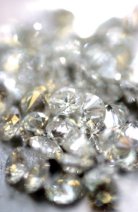GIA Identifies Carat-Plus CVD Synthetic Diamond
May 13, 10
 |
According to an item authored by Wuyi Wang and Kyaw Soe Moe in the May issue of GIA's Gems and Gemology monthly e-newsletter "eBrief," the 1.05-carat, pear-shaped stone was submitted to the lab for grading and was color graded as equivalent to a "G." In addition to pinpoint inclusions, the stone contained some feathers and fractures along the girdle and its clarity grade was equivalent to "I1."
"Clearly, CVD synthetic diamonds of better quality and size are being produced as the growth techniques continue to improve," the GIA report concludes.
While carat-plus laboratory-grown colored diamonds have been available for some time, companies, such as Boston-based Apollo Diamond, have not appeared to have had the same size success with developing larger sizes of colorless and near-colorless diamonds, at least until now. The newsletter item does not disclose the origin of this particular CVD-grown diamond.
In addition to ascertaining the stone's color and clarity, GIA notes that no fluorescence was observed when the stone was exposed to conventional long- and short-wave UV radiation, the eBrief states. The infrared absorption spectrum indicated that the diamond sample was type IIa.
Images taken with the DiamondView, which uses strong ultra short-wave radiation, showed strong orange-red fluorescence with some irregularly shaped regions of blue fluorescence.
Photoluminescence spectra collected at liquid-nitrogen temperature with laser excitations from the UV to IR regions, along with other properties, allowed GIA to identify the stone as a CVD-grown diamond, according to the eBrief.